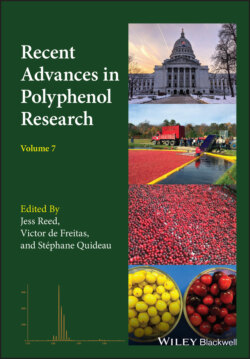Читать книгу Recent Advances in Polyphenol Research - Группа авторов - Страница 33
2.3.3 Oxidative Conversion from B‐type PAs (Route I)
ОглавлениеThis section describes the reported reactions based on Route I in Figure 2.8. In early attempts, Nonaka et al. (1987) used the oxidative conversion of the B‐type to the A‐type structure (Figure 2.9). Upon treatment of procyanidin B1 (5) with hydrogen peroxide under basic conditions, an oxidative conversion proceeded to give procyanidin A1 (6) in 13% yield. This protocol was further applied to other B‐type structures. For example, procyanidin B5 (7) and aesculitannin A (10) were converted to the corresponding compounds having the A‐type structure, i.e. procyanidin A7 (9) and aesculitannin C (11), albeit in low yields.
As other means of converting the B‐type structure into the A‐type structure, a radical‐mediated reaction was exploited (Figure 2.10) (Kondo et al. 2000). Upon treatment of procyanidin B1 (5) with 2,2‐diphenyl‐1‐picrylhydrazyl (DPPH), the C(2) hydrogen atom in the upper epicatechin unit was abstracted, inducing an oxidative cyclization to give procyanidin A1 (6), though the chemical yield was not reported.
